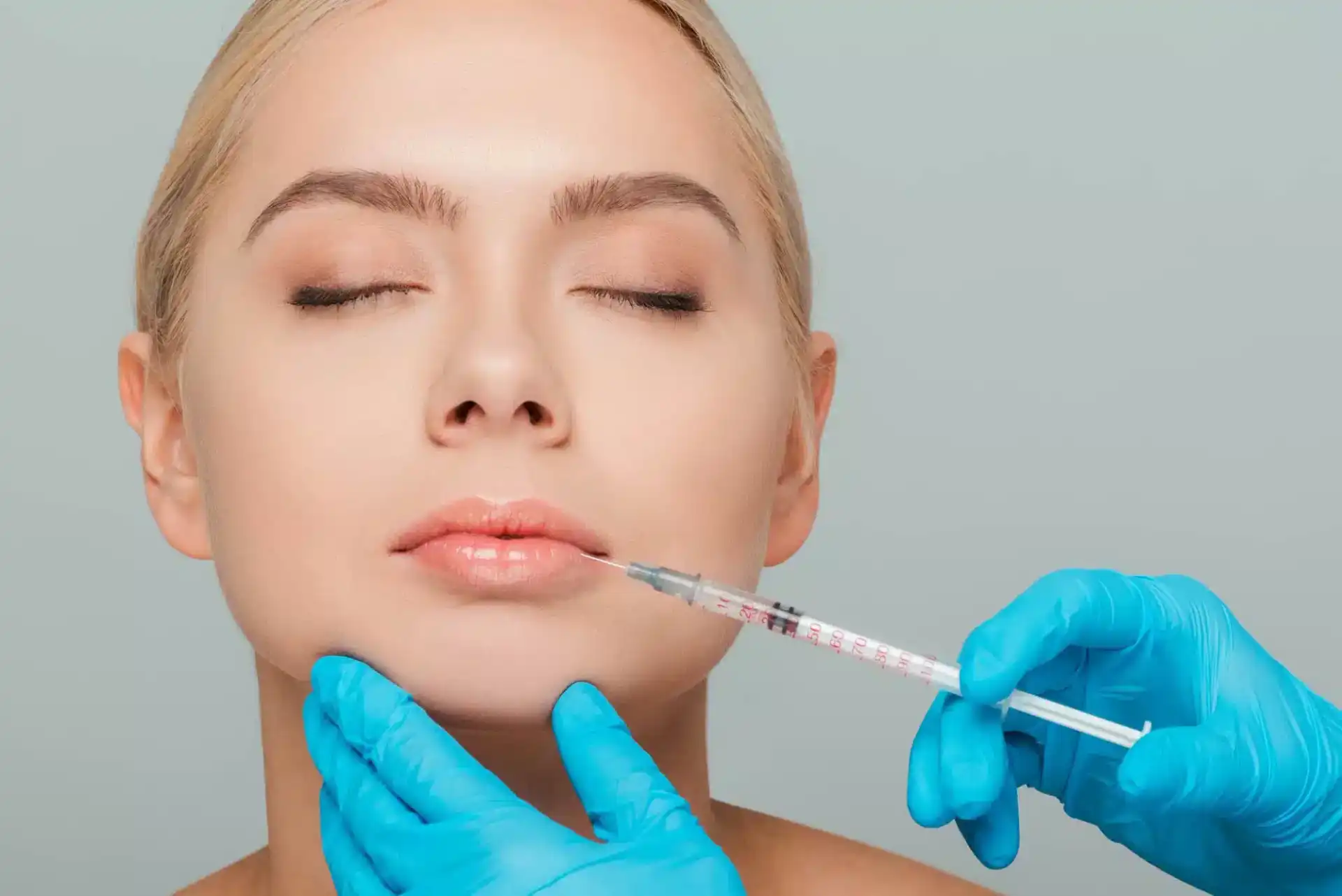Only for Licensed Professionals
Only for Licensed Professionals

Do Lip Fillers Hurt?
David Fuller
Last Updated On: October 15, 2024
Fortunately, modern cosmetology can correct many defects even without surgery. Lip gel injections have become increasingly popular as a cosmetic procedure.
However, one of the patient’s main concerns is whether the injections will hurt. Therefore, as a doctor, it is essential to understand the pain associated with lip filler injections and how to minimize it for your patients.
There are several techniques and strategies to make the procedure more comfortable for patients. By understanding the sources of pain and discomfort, you can give your patients a more positive experience and improve their satisfaction with the results.
What Are Lip Fillers?
Lip fillers, also known as lip augmentation, are a non-surgical aesthetic treatment involving injecting a dermal filler into the lips to add volume, shape, and definition. The most commonly used filler for lip augmentation is hyaluronic acid, a substance that occurs naturally in the body.
Hyaluronic acid fillers come in different formulations and thicknesses and can be tailored to each patient’s needs. They are a safe and effective way to enhance the appearance of the lips without surgery.
A wide variety of injectables characterizes the procedure. Various preparations based on hyaluronic acid are administered dermally, intraepidermally, subcutaneously, submuscular, etc.
Various techniques of administration of drugs are used – linear, fan, the method of separate injections, etc. But, of course, introducing drugs to a sufficiently deep depth and in significant volumes (1-10 ml) causes painful sensations.
Do Lip Fillers Hurt?
Many people ask these questions before deciding on the lip augmentation procedure: the answer is complex. Some people experience discomfort or pain during lip filler injections, while others do not. The degree of pain or discomfort depends on several factors, including:
- Pain tolerance: Everyone’s pain tolerance is different. Some individuals are more sensitive to pain than others and may experience more discomfort during the procedure.
- The location of the injection: Some areas of the lips may be more sensitive than others. In general, injections around the vermilion border (the outer edge of the lips) and the cupid’s bow (the “M” shape of the upper lip) may be more sensitive.
- The type of filler: Different fillers have different viscosities (thicknesses) and consistencies. Some may be more painful to inject than others.
- The technique of the injector: A skilled injector will use techniques to minimize pain and discomfort during the procedure.
Most people report that lip filler injections are not particularly painful. They may experience some discomfort or pressure during the injection, which typically subsides quickly.
In fact, many people report that the most uncomfortable part of the procedure is the initial numbing injection.
What Causes Pain During Lip Filler Injections?
Pain during lip filler injections can be caused by several factors, including:
Needle prick: The needle prick itself can cause discomfort, regardless of the area of the face being injected.
Sensitivity: The lips are part of the body with the most nerve endings, so they are highly sensitive, and injecting a foreign substance can cause significant discomfort.
Injection technique: The technique can also affect the level of lip filler pain experienced by the patient. If the needle is inserted too quickly or at an incorrect angle, it can cause more pain.
Volume and depth: Injecting too much filler or injecting too deep can cause more pain and discomfort.
How many days and how intensely the lips will hurt after augmentation depends on the depth of the punctures, the amount of injected filler, and individual sensitivity.
Sometimes the teeth are also involved in the process, as common channels of innervation can be affected. The injection area must be treated with an antiseptic to speed up healing and exclude the appearance of side effects in the form of inflammation. According to patient reviews, pain and discomfort pass within a few days.
Preparing The Patient For The Lip Augmentation Procedure
Before the treatment, the doctor collects an anamnesis to determine whether there are any contraindications for the lip augmentation.
First, the doctor must check whether there is no gel in the lips of the patient. If lip augmentation is performed for the first time, it is necessary to determine which drug was used before (biphasic or monophasic gel). The choice of filler will depend on this factor to not spoil the result or harm the patient’s health, and it also determines how painful lip fillers will be for the patient.
The doctor also examines the presence of herpes infection. If there is herpes on the lips, the procedure must be postponed. Otherwise, the introduction of the gel will increase the inflammatory process.
The doctor also needs to know if the patient is allergic to anesthetics. This will avoid the risk of anaphylactic shock and other unpleasant consequences.
According to the American Society for Aesthetic and Plastic Surgery, allergic reactions can range from persistent redness, swelling, or itching to swelling at the injection site. Other possible complications include bleeding, lip asymmetry, migration, and extrusion of implantable material.
How to Minimize Lip Injections Pain During The Procedure?
The following types of anesthesia are used to reduce or eliminate possible lip fillers pain:
- Application – a product in the form of a gel, cream, or sometimes a solution is applied to the intended areas of needle insertion. An occlusive bandage is used to accelerate and increase the depth of penetration. The method’s advantages are that it is safe, does not require special training, and quickly restores sensitivity. Disadvantages: it does not entirely block pain sensitivity, takes a lot of time (15–45 minutes), and local reactions to the drug may appear.
- Infiltration – layer-by-layer percolation of tissues with an anesthetic solution. The advantages are: the effect comes quickly, and it provides good pain relief. The disadvantages: it is relatively painful itself, and the effect lasts longer than the procedure.
- Conductive-reversible blockade of the transmission of nerve impulses along separate trunks. This type of local anesthesia has the same disadvantages as infiltration, requiring special training and a high level of specialist skill.
As a doctor, there are several techniques and strategies available to minimize pain during lip filler injections:
Numbing cream: Using a topical numbing cream can significantly reduce pain and discomfort during the injection. The cream should be applied to the lips at least 20 minutes before the procedure.
Ice: Applying ice to the lips before and after the injection can help to reduce swelling and discomfort.
Slow injection technique: Injecting the filler slowly and in small amounts can significantly reduce the level of pain experienced by the patient.
Small needle: Using a smaller needle can also reduce the pain associated with injections. A 30-gauge needle is the smallest and an excellent choice for lip injections.
Patient communication: Communicating with the patient throughout the procedure can help keep them calm and reduce anxiety, making the injection more comfortable.
Relaxation techniques: Some patients find it helpful to practice calming techniques, such as deep breathing or meditation, during the procedure.
Tips After The Lip Augmentation Procedure
To minimize discomfort, avoiding exposure to high or low ambient temperatures, visiting the sauna, and staying outside for a long time if the air temperature is close to +30 or freezing is necessary.
The main restrictions in the first days after the procedure include:
- Refraining from active facial expressions – do not smile widely, do not open your mouth wide;
- Avoiding hard foods (for example, apples) – avoid putting pressure on the lips when biting;
- Postponing the appointment with the dentist to a later period;
- Avoiding alcohol so as not to cause excessive thinning of the blood and, as a result, rapid removal of the gel from the body.
Using a cream with panthenol is permissible to eliminate irritation and pain after lip fillers.
Conclusion
While lip augmentation can cause some discomfort, doctors can use several techniques and strategies to minimize lip filler pain for their patients.
Learning and understanding the sources of pain and discomfort, will be of use when communicating with your patients about what to expect of the procedure. This will have a positive effect on ensuring they are comfortable and confident when in your care. With the implementation of these techniques and strategies, you can give your patients a strongly positive experience, also ensuring their satisfaction with results from lip filler injection procedures.
FAQ
Is there any pain after lip filler injections?
After lip filler injections, the patient may experience some mild pain or discomfort, swelling, and bruising. These reactions are normal and typically subside within a few days.
To manage any pain or discomfort, you can prescribe over-the-counter pain medication.
Are lip fillers more painful than Botox?
Comparing the pain levels of lip fillers and Botox injections can be subjective, as pain tolerance varies from person to person. However, lip fillers are considered to be more painful than Botox injections.
References
Galadari H, Mariwalla K, Delobel P, Sanchez-Vizcaino Mengual E. Pain and Bruising Levels After Lip Augmentation: A Comparison of Anterograde and Retrograde Techniques Using an Automated Motorized Injection Device. A Blinded, Prospective, Randomized, Parallel Within-Subject Trial. Dermatol Surg. 2020 Mar;46(3):395-401. doi: 10.1097/DSS.0000000000002055. PMID: 31453902.
Chiu A, Fabi S, Dayan S, Nogueira A. Lip Injection Techniques Using Small-Particle Hyaluronic Acid Dermal Filler. J Drugs Dermatol. 2016 Sep 1;15(9):1076-82. PMID: 27602969.
Liew, S. “A Comprehensive Approach to Lip Augmentation.” Plastic and Reconstructive Surgery, vol. 142, no. 3, 2018, pp. 265-274.
Smith SR, Lin X, Shamban A. Small gel particle hyaluronic acid injection technique for lip augmentation. J Drugs Dermatol 2013;12:764–9.
Cymrot N. Lip filler with hyaluronic acid – Light Lips Technique. Ann Dermatol Res. 2022; 6: 010-013. DOI: 10.29328/journal.adr.1001020.
Dreissigacker K. Chapter 5: injection techniques, entry points and treatment tips. In: Individual Face Balance, vol. 2. Paris, France: E2e Medical Publishing; 2011; pp. 199–254.
Products
Cart
Log In
Newsletter
Subscribe for exclusive offers and updates on new arrivals
Share feedback at:
Working Hours
MON - SUN 9AM to 6PM EST
The Most Popular Brands
Med Supply Solutions
Support
Secure checkout is guaranteed with full adherence to PCI DSS payment standards.
Products listed here are guaranteed authentic and manufacturer-sourced.
Pay easily with trusted providers


*Google and Apple Pay are currently only available via a direct link provided by your account manager.
Copyright 2025. Med Supply Solutions